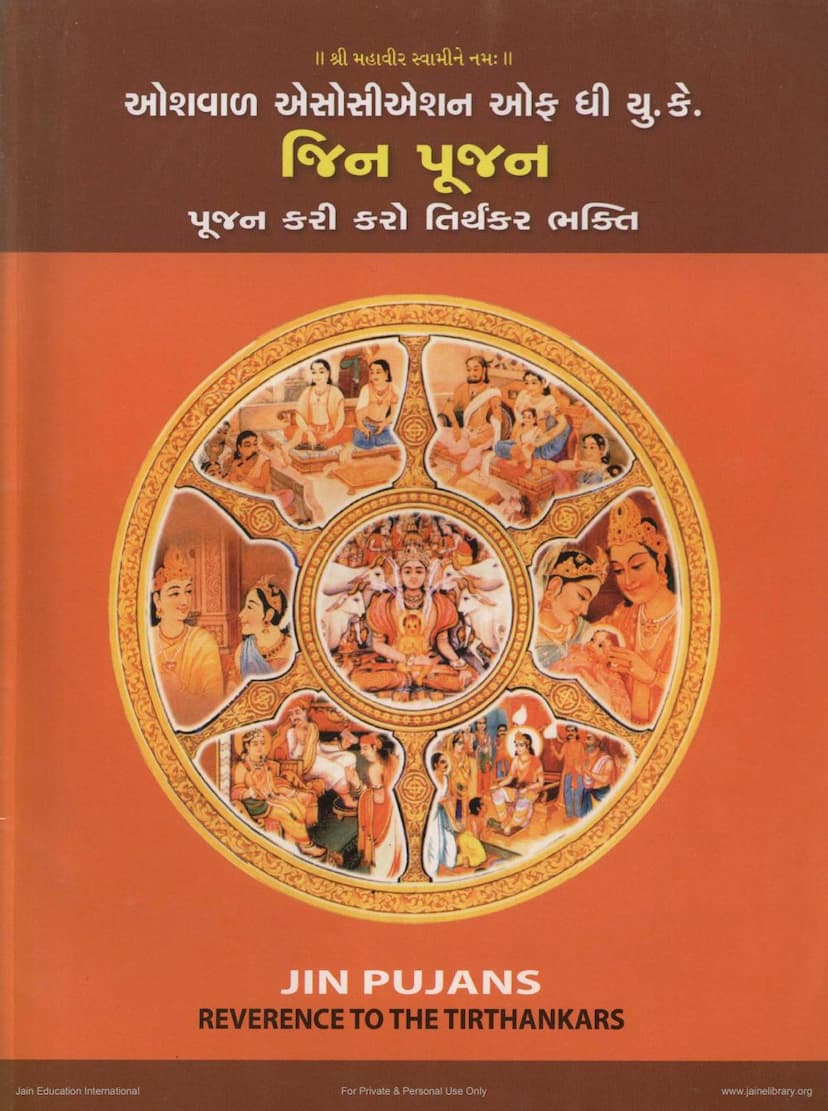Jina Poojan
Added to library: September 2, 2025

Summary
This document, "Jina Poojan" by the Oshwal Associations of The UK, serves as a comprehensive guide to Jain rituals and worship, primarily focused on the Pratishtha Mahotsav (consecration ceremony) of a new Jinalay (Jain temple). It aims to explain the significance and execution of various Pujas (worships) and Poojans (ritualistic ceremonies) to devotees.
Core Purpose and Philosophy:
- Moksha (Salvation): The ultimate goal of Jainism is liberation from the cycle of birth and death, achieving eternal happiness. Rites and rituals are seen as important steps towards this path.
- Reverence to Tirthankars: The primary purpose of these rituals is to pay respect to the Tirthankars (Jinas) who have attained salvation and shown the path to liberation. The aim is to gain inspiration from them and emulate their virtues.
- Inner Transformation: Jain rituals are not performed for worldly gains or to appease divine powers. Instead, they are meant to foster inner peace, discipline the mind, suppress passions (anger, ego, deceit, greed), and imprint Jain principles onto the aspirant's consciousness.
- Anekäntväd (Multiple Viewpoints): The booklet acknowledges that there are diverse ways of performing Jinapuja and aims to present its approach without intending to offend anyone.
- Purity: A strong emphasis is placed on purity—physical, of clothes, mind, ground, worship items, money, and the overall ceremony—as it directly influences the purity of thought and the efficacy of the ritual.
Key Concepts and Rituals Explained:
- Bhakti and Puja: These are considered integral to a Jain's daily life and represent the purest form of the soul's conduct. There are nine types of Bhakti, and Jinapuja aims to incorporate all of them.
- Saguna vs. Nirguna Puja: Saguna Jinapuja involves worshipping the Jina in an idol or image form, while Nirguna Jinapuja is the worship of the Jina as a formless spiritual idea. Saguna worship is particularly important for beginners and up to the seventh Gunasthän (spiritual stage).
- Ashtaprakäri (Eight-Fold) Jinapuja: This is a common daily puja performed with eight specific offerings:
- Jal Puja (Water): Symbolizes washing away karmic impurities.
- Chandan Puja (Sandalwood): Represents coolness, peace, and right knowledge. It involves a "Nav Angi Puja" (worship of nine body parts) with detailed symbolic meanings for each.
- Pushpa Puja (Flower): Symbolizes conduct filled with love and compassion, without discrimination.
- Dhoop Puja (Incense): Represents the selfless life of monks and nuns, and the aspiration for asceticism.
- Dipak Puja (Light): Symbolizes pure consciousness and liberated souls, inspiring one to follow the vows.
- Akshat Puja (Rice): Represents the last birth and unbroken happiness, symbolizing purity.
- Naivedya Puja (Sweets): Encourages reducing attachment to tasty food, aiming for a state of non-dependence.
- Fal Puja (Fruit): Symbolizes Moksha or liberation, achieved through detachment and righteous living.
- Bhav Puja: Consists of Chaitya Vandan, Stavan, and Stuti, which bring happiness and help destroy passions and karmas.
- Ärati and Mangal Deevo: These rituals, originating around the 12th century, are performed to express spiritual joy, seek an end to suffering, and illuminate the self with spiritual light. The five lamps in Ärati symbolize the five great vows or other important Jain principles.
- Shanti Kalash: A ritual for inner and external peace for all beings, performed with chanting of mantras and continuous flow of Panchämrut, mirroring the celestial bathing of Tirthankars.
- Snätra Puja: A symbolic re-enactment of the bathing of newborn Tirthankars by celestial beings. It commemorates the five Kalyanakas (auspicious events) of a Tirthankar's life and is considered compulsory before any other puja.
- Specific Poojans for Pratishtha Mahotsav: The booklet details various Poojans performed during the consecration ceremony, including:
- Shri Kumbh Sthäpanä Pujä (Installation of auspicious pot)
- Shri Akhand Dipak Sthäpanä Pujä (Installation of eternal lamp)
- Shri Jwärä Ropan (Sowing of auspicious grains)
- Shri Manek Stambha Ropan (Installation of a small pillar)
- Shri Toran Bandhan (Tying of auspicious garland)
- Shri Laghu Nandavarta Poojan (Worship of the Nandavarta Yantra)
- Shri Parshva Panch Kalyanak Pujä (Worship of the five auspicious events of Lord Parshvanath's life)
- Shri Nav Grah Patla-Poojan (Worship of the nine planets)
- Shri Dush Dikpäl Patla-Poojan (Worship of the ten directional protectors)
- Shri Ashta Mangal Patla-Poojan (Worship of the eight auspicious symbols)
- Shri Siddha Chakra Poojan (Grand worship of the Siddhachakra Yantra and Navpadaji)
- Shri Bhagwati Mandal Poojan (Worship of guardian deities)
- Shri Bhakatamar Poojan (Recitation of the Bhaktamar Stotra)
- Rathyatra (Chariot procession)
- Marriage Ceremony and Coronation Event (as part of a Tirthankar's life)
- Pratishthä (Ceremonial Installation Vidhi)
- Shikhar Kalash Sthäpan & Shikhar Dhvaja Sthäpan (Installation of pinnacle and flag)
- Shri Bruhad Shanti Snatra Poojan (Special oblation for universal peace)
- Temple Dwär Opening (Inauguration), First Darshan & Pujä
- Shri SattarBhedi Pujä (Worship for seeking forgiveness)
- Adhar Abhishek Pujä (Eighteen oblations for purity)
In summary, "Jina Poojan" is a meticulously compiled resource that provides a deep understanding of the spiritual significance and practical execution of various Jain rituals. It emphasizes devotion, purity, and the pursuit of Moksha through the veneration of Tirthankars and the assimilation of their teachings.